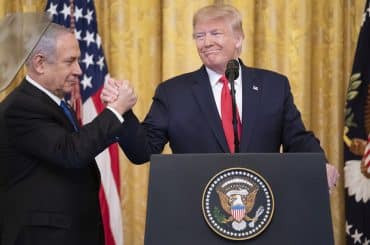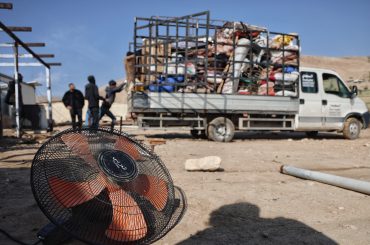
I am writing to alert people about an incident that happened at the Gagosian gallery Saturday, December 18, 2010, on the last day of the Anselm Kiefer exhibition, Next Year In Jerusalem.
In response to the title of the exhibition and the content of the work [occupations/historical memory] a small group of artists and activists decided to view the show wearing a shirt with the words Next Year In Jerusalem in the three languages Arabic, Hebrew and English.
We spent about one to two hours looking at the exhibition, mainly individually, silently and respectfully with full consideration of others viewing the exhibition. We simply wore the words on our shirts and did not engage with anyone unless they struck up a conversation with us. A number of people asked some of us about the meaning of the message, gave positive feedback, showed interest, asked where they could get the shirts or occasionally questioned our political attitude toward Israel and Palestine. We made it clear to those who asked that we were not affiliated with the gallery and this was our own personal response to the work. All our conversations were at a low level, similar to all the other visitors talking with one another while viewing the show. We never had an incident, raised our voices, disrupted anyone, and were not approached by the multitudes of guards that were there. We took photographs as was permitted and similar to many other people photographing the work and each other without flash or disruption to people’s passage. We thought we were in an arena of ideas and that words on a t-shirt without any other provocation would be an acceptable method of free expression in response to Kiefer’s work. We were so very wrong.
After about one and a half hours, half of our group left and four of us remained to continue to view the show. I walked around on my own looking at the work. I noticed that two other visitors had engaged two of my friends in a conversation that was lasting a long time. Curious, I wandered over to where they were standing to join them. The atmosphere in the gallery was very peaceful and calm. The conversation that they had struck-up was warm and all of them were very interested talking together. Suddenly, out of nowhere, two representatives from the gallery approached us. One of them asked who our leader was. It was an odd question and I responded that we had no leader. She then asked us who was in charge. And again I emphasized that no one was in charge and said that there was nothing happening. She then said that she had to ask us to leave the gallery. We, including the lovely couple we had just met, were dumbfounded. At that point, the gallery employee ordered the guards, the same ones that had observed us for close to two hours with no incident, to surround us and escort us out. I told her that there was no reason to have us removed. The gallery employee explained that they had received complaints about the words on our shirt, which were causing confusion, and therefore we would have to leave. We then decided to cover the language even though it was very disturbing to do so and we did this reluctantly, understanding the profound irony against the back-drop of the Kiefer exhibition which embodies a life’s work supposedly concerned with the horrors of state-sponsored repression, the brutality of occupation, racism, abuse of power, fascism and the consequences of forgetting history, not allowing for keen reflection in regard to current strains of unchecked power. I mentioned to the gallery employees that I thought we were in the realm of ideas inside the gallery space to which she replied that it was a private gallery in the business of selling art and that they wanted us to leave. On principle, something no longer that valued or defended in the public or private sector, we stayed, acting again in no way that could be deemed disruptive. The guards went back to their corners and we went back to our conversation. We thought that the incident was over. To all our shock, several minutes later the police arrived and completely disrupting the calm atmosphere in the gallery began to order us to leave and threatened us with arrest for trespassing.
Within minutes after the police arrived an incident unfolded that could only be described as brutal. Upon reflection, it was like a staged scene, depicting what happens when the very forces Kiefer warns us about go unchecked. The police came on very strong and at first directed their warning at us, overseen by the gallery personnel, who pointed us out to them. I asked them to explain the complaints being made against us and rationale for our expulsion. The only explanation given was that it was a private space just like one’s home and that we were no longer welcome and would need to leave. A woman witnessing the event and standing at a distance to my left, who I did not know, asked for an explanation as to what was happening. The police officer was very rude and belligerent to her. All this unfolded rather quickly, within seconds and suddenly I saw him grab her forcefully, pinching the muscle of her arm as he began to drag her from the gallery. It was shocking as she was screaming that she was being hurt and yet he wouldn’t remove his grip. I heard her cry in pain all the way out as she was being removed to the entrance. I couldn’t see what happened behind the wall between us but have heard an account from another witness that she fell to the floor and was dragged all the way to the door and outside on the floor by the police without complaint and in full view of the gallery personnel. She was badly bruised and needed medical attention and was taken to a hospital emergency room.
These are the facts of my experience as it unfolded. It was and still is traumatizing to recount and to attempt to grapple with all the implications of these events unfolding against the backdrop of the Anselm Kiefer exhibition. What happened there can not be explained away simply by the gallery stating that they received complaints. The question should be asked by whom? What was the content of those complaints? What was the confusion they pointed to and why couldn’t the gallery personnel clear those issues up? What warranted setting into motion this course of action that led to a brutal assault by the police and the shutting down of ideas and speech embodied on a personal t-shirt? These (art) corporations are about money – rank and extreme consumerism. That they invoke the culture of private property as justification for their repression of inconvenient thoughts and ideas must not obscure the fact that they have no right to cause actual physical harm to members of the public or to violate the rights of that public. Our peaceful engagement with the Kiefer exhibition was not a demonstration that day in the gallery but the gallery deserves now to be shown what a real demonstration looks like in response to what it did.
I can only wonder what Anselm Kiefer would have to say about what happened in his exhibition because of the presence of those words that inspired him and led to an inspired idea, Next Year In Jerusalem, strung together in Arabic, Hebrew and English?

